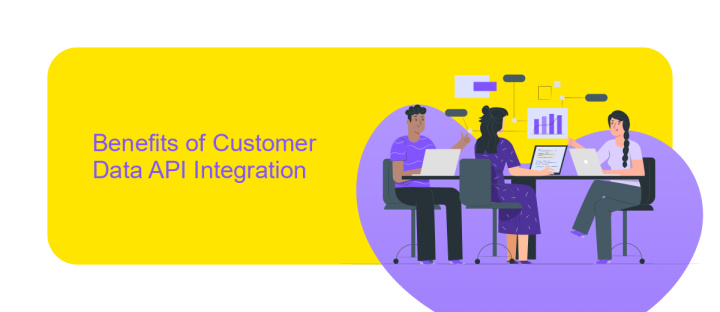Customer Data API Integration
In today's digital age, seamless customer data integration is crucial for businesses striving to enhance user experiences and drive growth. Customer Data API Integration simplifies this process by enabling the efficient transfer and management of customer information across various platforms. This article explores the benefits, implementation strategies, and best practices for integrating Customer Data APIs to optimize your business operations.
Introduction
In today's data-driven world, businesses are increasingly relying on customer data to make informed decisions, enhance user experiences, and drive growth. Integrating a Customer Data API into your systems can streamline the process of collecting, managing, and utilizing this valuable information. By leveraging such an API, companies can gain a competitive edge, improve customer satisfaction, and optimize their operations.
- Efficient data collection from multiple sources
- Centralized data management and storage
- Real-time data updates and synchronization
- Enhanced data security and compliance
- Improved customer insights and analytics
Implementing a Customer Data API integration requires careful planning and execution. It involves selecting the right API provider, ensuring data compatibility, and setting up robust security measures. This article will guide you through the essential steps and best practices to successfully integrate a Customer Data API, helping you unlock the full potential of your customer data and drive your business forward.
Benefits of Customer Data API Integration

Integrating a Customer Data API offers numerous advantages for businesses, enhancing their ability to manage and utilize customer information effectively. One of the primary benefits is the seamless synchronization of customer data across various platforms, which ensures that all departments have access to the most up-to-date information. This leads to improved decision-making and a more personalized customer experience, as businesses can tailor their services and communications based on real-time data insights.
Additionally, services like ApiX-Drive simplify the integration process, allowing businesses to connect their customer data with other applications without extensive technical knowledge. ApiX-Drive offers automated workflows and a user-friendly interface, making it easier to manage data flows and integrations. This not only saves time and resources but also reduces the risk of errors, ensuring that customer data is accurate and consistent across all systems. Ultimately, leveraging a Customer Data API integration can significantly enhance operational efficiency and customer satisfaction.
Considerations for Integration

When integrating a Customer Data API, several key considerations must be taken into account to ensure a seamless and efficient process. Understanding these factors can help avoid potential pitfalls and maximize the benefits of the integration.
- Data Security: Ensure that the API complies with data protection regulations such as GDPR or CCPA. Implement encryption and secure authentication methods.
- Scalability: Evaluate whether the API can handle the volume of data and user load as your business grows.
- Compatibility: Verify that the API is compatible with your existing systems and software to avoid integration issues.
- Documentation: Comprehensive and clear documentation is crucial for a smooth integration process. Ensure the API provider offers detailed guides and support.
- Latency: Consider the response time of the API, especially if real-time data processing is critical for your operations.
By carefully evaluating these considerations, businesses can ensure a successful Customer Data API integration, leading to improved data management and enhanced customer experiences. Proper planning and attention to these factors are essential for leveraging the full potential of the API.
Best Practices for Implementation

Implementing a Customer Data API requires careful planning and adherence to best practices to ensure efficiency, security, and scalability. Proper implementation not only optimizes performance but also safeguards sensitive customer information.
First, prioritize data privacy and compliance with regulations such as GDPR and CCPA. Ensure that your API handles data securely, using encryption and secure authentication methods. Moreover, consider the principle of least privilege to limit access to sensitive data.
- Use RESTful principles for API design to ensure consistency and predictability.
- Implement rate limiting and throttling to prevent abuse and ensure fair usage.
- Employ comprehensive logging and monitoring to track API usage and identify potential issues.
- Ensure robust error handling to provide meaningful feedback and maintain API reliability.
- Regularly update and patch your API to protect against vulnerabilities.
Finally, provide thorough documentation and support for your API users. Clear, detailed documentation helps developers understand how to effectively integrate and use the API, reducing the likelihood of errors and enhancing overall user satisfaction.
- Automate the work of an online store or landing
- Empower through integration
- Don't spend money on programmers and integrators
- Save time by automating routine tasks
Conclusion
In conclusion, integrating Customer Data APIs is a pivotal step for businesses aiming to enhance their customer relationship management and streamline their operations. By leveraging these APIs, companies can gain deeper insights into customer behavior, preferences, and trends, enabling more personalized and effective marketing strategies. This not only improves customer satisfaction but also drives business growth and efficiency.
Utilizing services like ApiX-Drive can significantly simplify the integration process, providing a user-friendly platform to connect various applications and automate data transfers seamlessly. ApiX-Drive offers robust solutions that ensure data accuracy and integrity, reducing the manual workload and potential errors. As businesses continue to evolve in the digital age, the ability to efficiently manage and utilize customer data through API integrations will remain a critical factor in achieving competitive advantage and operational excellence.
FAQ
What is Customer Data API Integration?
Why is Customer Data API Integration important for businesses?
How can I ensure the security of customer data during API integration?
What are the common challenges faced during Customer Data API Integration?
Are there tools available to simplify Customer Data API Integration?
Apix-Drive is a universal tool that will quickly streamline any workflow, freeing you from routine and possible financial losses. Try ApiX-Drive in action and see how useful it is for you personally. In the meantime, when you are setting up connections between systems, think about where you are investing your free time, because now you will have much more of it.


